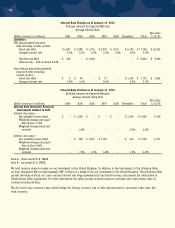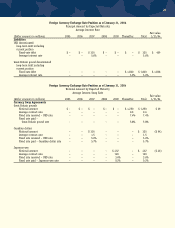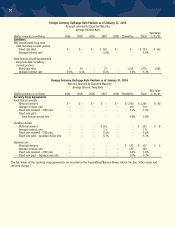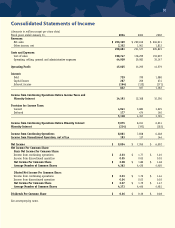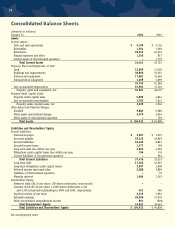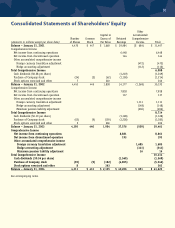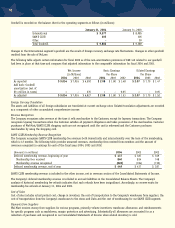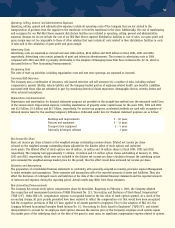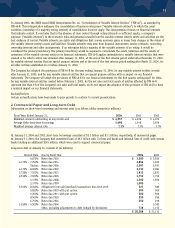Walmart 2004 Annual Report Download - page 33
Download and view the complete annual report
Please find page 33 of the 2004 Walmart annual report below. You can navigate through the pages in the report by either clicking on the pages listed below, or by using the keyword search tool below to find specific information within the annual report.
New Accounting Pronouncements
On February 1, 2003, the Company adopted the expense recognition provisions of FAS No. 123, “Accounting and Disclosure of Stock-
Based Compensation” (“FAS 123”). Under FAS 123, compensation expense is recognized based on the fair value of stock options granted
using the Black Scholes option valuation model. The Company has chosen to retroactively restate its results of operations for the
accounting change. Following the provisions of FAS 123, fiscal 2004, 2003 and 2002 includes a reduction of net income of $102 million,
$84 million and $79 million, respectively, or $0.02 in each fiscal year.
In August 2001, the FASB issued FAS No. 143, “Accounting for Asset Retirement Obligations.” This statement requires the Company to
recognize the fair value of a liability associated with the cost the Company would be obligated to incur in order to retire an asset at
some point in the future. The liability would be recognized in the period in which it is incurred and can be reasonably estimated. The
standard is effective for fiscal years beginning after June 15, 2002. The Company adopted this standard at the beginning of this fiscal
year. The adoption of this standard did not have a material impact in fiscal 2004.
In July 2002, the FASB issued FAS No. 146, “Accounting for Costs Associated with Exit or Disposal Activities” (“FAS 146”). FAS 146
addresses financial accounting and reporting for costs associated with exit or disposal activities and replaces the FASB’s Emerging Issues
Task Force (“EITF”) 94-3, “Liability Recognition for Certain Employee Termination Benefits and Other Costs to Exit an Activity (including
Certain Costs Incurred in a Restructuring).” FAS 146 requires that a liability for a cost associated with an exit or disposal activity be
recognized when the liability is incurred. FAS 146 also establishes that fair value is the objective for initial measurement of the liability.
The statement is effective for exit or disposal activities initiated after December 31, 2002. The adoption of FAS 146 in fiscal 2004 did
not have a material impact on the Company’s financial statements.
In April 2003, the FASB issued FAS No. 149, “Amendment of Statement 133 on Derivative Instruments and Hedging Activities”
(“FAS 149”). This statement amends and clarifies accounting for derivative instruments and is effective for contracts entered into or
modified after June 30, 2003. The adoption of FAS 149 did not have a material impact on our financial statements.
In May 2003, the FASB issued FAS No. 150, “Accounting for Certain Financial Instruments with Characteristics of both Liabilities and
Equity” (“FAS 150”). FAS 150 clarifies the classification and measurement of certain financial instruments with characteristics of both
liabilities and equity and is effective for financial instruments entered into or modified after May 31, 2003, or otherwise for the first
interim period beginning after June 15, 2003. The adoption of FAS 150 did not have a material impact on our financial statements.
In November 2002, the EITF reached a consensus on EITF 02-16, “Accounting by a Reseller for Cash Consideration Received from a
Vendor” (“EITF 02-16”), which addresses the accounting for “Cash Consideration” (which includes slotting fees, cooperative advertising
payments, etc.) and “Rebates or Refunds” from a vendor that are payable only if the merchant completes a specified cumulative level of
purchases or remains a customer of the vendor for a specified period of time. EITF 02-16 establishes an overall presumption that all
consideration from vendors should be accounted for as a reduction of item cost and be recognized at the time the related inventory is
sold. EITF 02-16 provides that the overall presumption can be overcome in two ways. First, consideration representing a payment for
assets or services delivered to a vendor should be classified as revenue or other income. Second, consideration representing a
reimbursement of a specific, incremental, identifiable cost incurred in selling the vendor’s product should be recorded as a reduction of
that expense. Wal-Mart had historically recorded certain consideration from vendors as a reduction of expenses, primarily advertising.
We adopted EITF 02-16 on February 1, 2003, and now account for this consideration as a reduction of purchases. The adoption of
EITF 02-16 resulted in an after-tax impact of approximately $140 million, or $0.03 per share.
In November 2003, the FASB ratified the EITF’s consensus on Issue 03-10, “Application of Issue 02-16 by Resellers to Sales Incentives
Offered to Consumers by Manufacturers” (“EITF 03-10”), which amends EITF 02-16. This consensus requires that if certain criteria are
met, consideration received by a reseller in the form of reimbursement from a vendor for honoring the vendor’s sales incentives offered
directly to consumers, such as manufacturer’s coupons, should not be recorded as a reduction of the cost of the reseller’s purchases
from the vendor. The adoption of EITF 03-10, which is required for us on February 1, 2004, did not have a material impact on our
financial statements.
In January 2003, the FASB issued FASB Interpretation No. 46, “Consolidation of Variable Interest Entities” (“FIN 46”), as amended by
FIN 46-R. This interpretation addresses the consolidation of business enterprises (“variable interest entities”) to which the usual
condition (ownership of a majority voting interest) of consolidation does not apply. This interpretation focuses on financial interests
that indicate control. It concludes that in the absence of clear control through voting interests or sufficient equity, a company’s
exposure (“variable interest”) to the economic risks and potential rewards from the variable interest entity’s assets and activities are the
best evidence of control. Variable interests are rights and obligations that convey economic gains or losses from changes in the values of
the variable interest entity’s assets and liabilities. Variable interests may arise from financial instruments, service contracts, nonvoting
ownership interests and other arrangements. If an enterprise holds a majority of the variable interests of an entity, it would be
considered the primary beneficiary. The primary beneficiary would be required to consolidate the assets, liabilities and the results of
31









